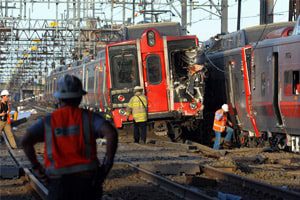
The Metro-North commuter train that derailed in the Bronx just about 10 miles outside of New York City was traveling at high speeds as it went into a curve just before jumping the tracks. At the 30 mile-per-hour (mph) curve, the train was speeding at 82 mph, according to initial information, the National Transportation Safety […]
 The Metro-North commuter train that derailed in the Bronx just about 10 miles outside of New York City was traveling at high speeds as it went into a curve just before jumping the tracks.
The Metro-North commuter train that derailed in the Bronx just about 10 miles outside of New York City was traveling at high speeds as it went into a curve just before jumping the tracks.
At the 30 mile-per-hour (mph) curve, the train was speeding at 82 mph, according to initial information, the National Transportation Safety Board (NTSB) just said, according to FoxNews. Earl Weener, NTSB board member, stated that it is too early to say if human or equipment error led to the deadly crash. “That’s the question we need to answer,” Weener said at a news conference.
Four people died and dozens were injured in the crash.
Weener, speaking at a press conference with Democratic senators Charles Schumer (New York) and Richard Blumenthal (Connecticut), said that the train was traveling at speeds that were too high for the 70 mph zone it had passed before it reached the 30 mph curve near the Spuyten Duyvil station on Metro-North’s Hudson Line. The curve is one of the system’s steepest, according to The New York Times.
The station is located just where the Hudson and Harlem rivers meet at a sharp, 30 mph, bend. The locomotive fell, bringing some of is seven cars with it and dumping some cars just inches from the rivers, noted FoxNews. Two data recorders and some “low quality” surveillance footage were collected and are being examined, said Weener. Testing for drugs and alcohol was being conducted on the train’s driver, as well. The train operator’s cell phone was also collected, The New York Times reported. William Rockefeller, the train’s operator, was being interviewed by the NTSB and will continue to be interviewed “for the next couple of days,” Weener said, according to FoxNews.
Rockefeller told investigators that he attempted to hit the brakes when the train traveled into the bend, but that they didn’t work, according to The New York Post, citing law enforcement sources who also described Rockefeller as a having worked at the MTA for 20 years and as having a clean disciplinary record. Some 150 people were on board at the time of the crash.
According to The New York Times, the train’s throttle was still engaged, which means the engine was receiving power, until just six seconds before the locomotive came to a stop. The locomotive is situated in the rear of the train. The power shift came “very late in the game,” said Weener.
Authorities noted that the train’s brakes appeared to be working appropriately just before the crash. “We are not aware of any problems or anomalies with the brakes,” Weener said, according to The New York Times. Senator Schumer pointed out that, “The train did make nine stops before coming to this curve. So clearly the brakes were working a short time before.” Schumer said that the NTSB said the tracks appeared to be in proper condition.
Ahn Kisook, 35, of Queens, New York; Donna L. Smith, 54, of Newburgh, NY; James G. Lovell, 58, of Cold Spring, NY; and James M. Ferrari, 59, of Montrose, NY, died in the what is now considered to be the deadliest crash in the system’s history, according to the MTA Police Department. Three of those who died Sunday were found outside the train; one was inside, authorities said. Autopsies are underway, according to The New York Times.
Earlier this year, an eastbound-westbound crash in Bridgeport, Connecticut, left the eastbound train derailed and 73 passengers, two engineers, and a conductor injured, according to FoxNews.


